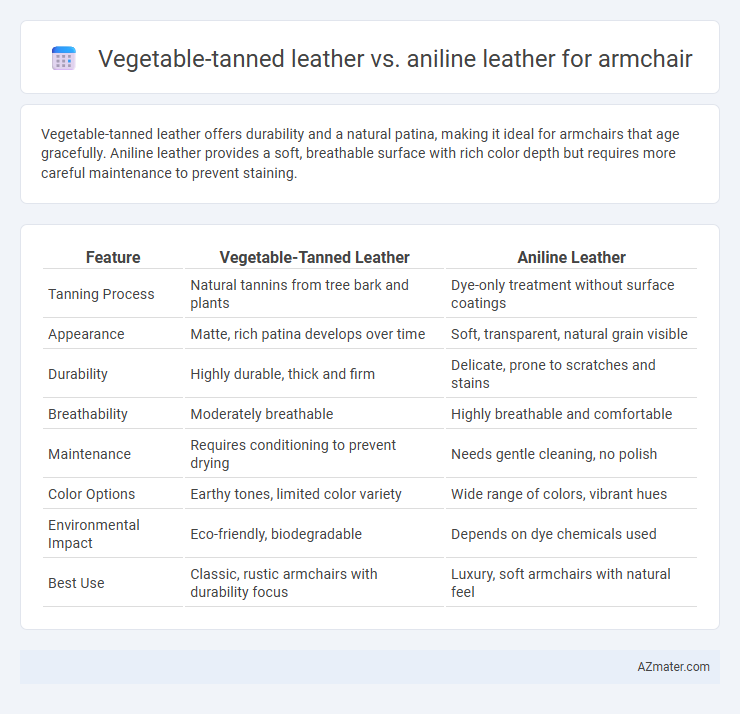Vegetable-tanned leather offers durability and a natural patina, making it ideal for armchairs that age gracefully. Aniline leather provides a soft, breathable surface with rich color depth but requires more careful maintenance to prevent staining.
Table of Comparison
| Feature | Vegetable-Tanned Leather | Aniline Leather |
|---|---|---|
| Tanning Process | Natural tannins from tree bark and plants | Dye-only treatment without surface coatings |
| Appearance | Matte, rich patina develops over time | Soft, transparent, natural grain visible |
| Durability | Highly durable, thick and firm | Delicate, prone to scratches and stains |
| Breathability | Moderately breathable | Highly breathable and comfortable |
| Maintenance | Requires conditioning to prevent drying | Needs gentle cleaning, no polish |
| Color Options | Earthy tones, limited color variety | Wide range of colors, vibrant hues |
| Environmental Impact | Eco-friendly, biodegradable | Depends on dye chemicals used |
| Best Use | Classic, rustic armchairs with durability focus | Luxury, soft armchairs with natural feel |
Introduction to Leather Types for Armchairs
Vegetable-tanned leather, produced using natural tannins from tree bark and plant materials, offers durability, a rich patina, and eco-friendly qualities ideal for armchairs. Aniline leather, dyed with soluble dyes that preserve the natural surface and grain, provides a soft, breathable texture but requires careful maintenance to prevent staining. Both types enhance the aesthetic and comfort of armchairs, making the choice dependent on durability needs and desired appearance.
What is Vegetable-Tanned Leather?
Vegetable-tanned leather is crafted using natural tannins extracted from tree bark, leaves, and other plant materials, resulting in a durable and eco-friendly material. This type of leather develops a rich patina over time, enhancing the aesthetic appeal of armchairs with its unique aging characteristics. Its breathable and firm texture makes it an excellent choice for upholstery, providing long-lasting comfort and durability in furniture.
What is Aniline Leather?
Aniline leather is a type of leather dyed exclusively with soluble dyes that preserve the natural surface and texture, offering a soft, breathable, and luxurious finish ideal for armchairs. Unlike vegetable-tanned leather, which undergoes a tanning process using natural tannins, aniline leather retains its natural markings and hides, giving each armchair a unique and authentic appearance. Its porous nature requires careful maintenance to protect against stains and fading while enhancing the comfort and aesthetic appeal of premium leather armchairs.
Visual Differences: Texture and Color
Vegetable-tanned leather features a rich, natural texture with visible grain patterns and subtle color variations that develop a unique patina over time, enhancing its character and rustic appeal. Aniline leather boasts a smooth, soft surface with a more uniform coloration, showcasing the hide's natural imperfections and retaining a translucent finish that highlights its luxurious quality. The choice between these leathers impacts the armchair's aesthetic, where vegetable-tanned leather offers a rugged, vintage look, while aniline leather provides a sleek, elegant appearance.
Durability and Longevity Comparison
Vegetable-tanned leather offers exceptional durability due to its natural tanning process, which results in a firmer and thicker hide that resists wear and develops a rich patina over time. Aniline leather, though softer and more breathable, is less resistant to stains and scratches because it lacks a protective coating, making it more susceptible to damage in high-use armchairs. For long-term longevity, vegetable-tanned leather is preferred as it withstands daily use and aging better, maintaining structural integrity and aesthetic appeal in armchair upholstery.
Comfort and Feel: Which Leather is Softer?
Vegetable-tanned leather offers a firm yet supple texture that softens over time, providing a natural, breathable feel that enhances comfort in armchairs. Aniline leather is typically softer and more pliable from the start, with its natural grain maintained through minimal treatment, resulting in a luxurious, smooth surface that molds easily to the body. For immediate softness and plush comfort, aniline leather is superior, while vegetable-tanned leather excels in developing a unique, personalized softness with age and use.
Maintenance and Care Requirements
Vegetable-tanned leather requires regular conditioning to prevent drying and cracking due to its natural, porous surface that absorbs oils and moisture. Aniline leather, treated only with transparent dyes, demands gentle cleaning with pH-balanced leather cleaners and routine maintenance to preserve its soft, breathable texture and prevent staining. Both types benefit from avoiding direct sunlight and moisture exposure to maintain their durability and aesthetic appeal.
Eco-Friendliness and Sustainability
Vegetable-tanned leather for armchairs offers superior eco-friendliness due to its natural tannins derived from plant sources, avoiding harmful chemicals used in chrome tanning processes common in other leathers. Aniline leather, while prized for its rich, natural appearance, typically involves fewer coatings but requires more intensive chemical treatments that can impact environmental sustainability. Choosing vegetable-tanned leather supports sustainable practices by promoting biodegradability and reducing toxic waste, making it a more environmentally responsible option for eco-conscious consumers.
Cost Differences for Armchair Buyers
Vegetable-tanned leather typically costs less than aniline leather due to its more durable processing methods and availability of sourcing materials. Aniline leather requires high-quality hides and extensive hand-dyeing, driving up prices for armchair buyers seeking a luxurious, natural finish. Budget-conscious shoppers might choose vegetable-tanned leather for affordability and durability, while premium buyers prioritize aniline leather's soft, natural appearance despite higher costs.
Best Choice for Your Armchair: Final Recommendations
Vegetable-tanned leather offers durability and natural patina ideal for armchairs with frequent use, providing a sturdy and eco-friendly option. Aniline leather, prized for its soft texture and rich, natural appearance, suits armchairs in low-traffic areas where luxurious comfort is a priority. For longevity and ease of maintenance, vegetable-tanned leather is recommended, whereas aniline leather is best chosen for aesthetic appeal and softness in less demanding environments.

Infographic: Vegetable-tanned leather vs Aniline leather for Armchair
 azmater.com
azmater.com